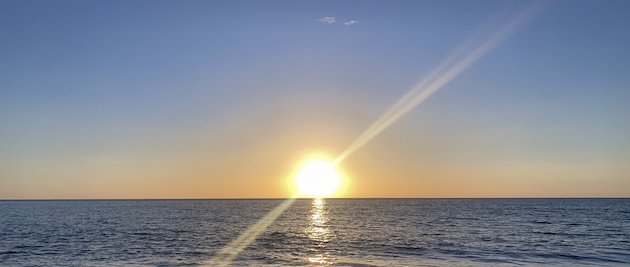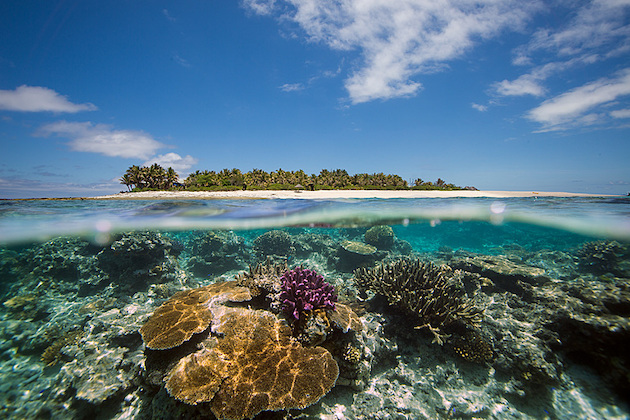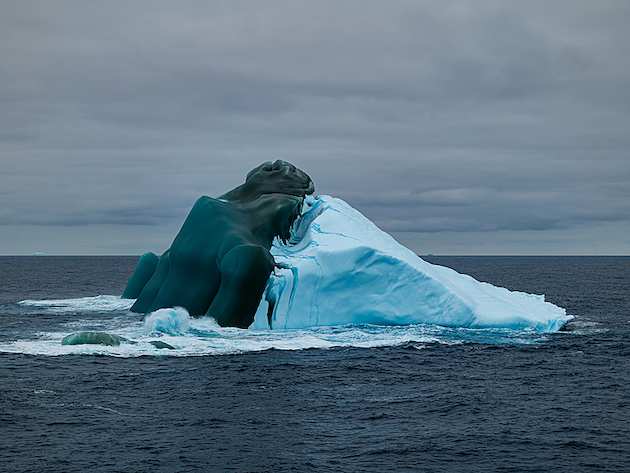[ad_1]

NEW YORK, Jun 08 (IPS) – The main target of carbon seize and storage has lengthy been on coastal ecosystems like mangroves and seagrasses. If the world needs to fulfill its looming local weather targets, then it’s time to go to the excessive seas — the house of deep blue carbon.Nearly half of the world’s inhabitants lives in coastal zones. For islands within the Pacific and Caribbean islands akin to Dominica, the place as much as 90 p.c of the inhabitants lives on the coast, the ocean is prime to lives and livelihoods. From fisheries to tourism and transport, this important physique which covers over 70 p.c of the planet, is a lifeline.
However the ocean’s life-saving potential extends a lot additional. The ocean regulates our local weather and is vital to mitigating local weather change. Researchers have lengthy lamented that main worldwide agreements have didn’t adequately acknowledge the useful resource that produces half of the earth’s oxygen and whose energy consists of absorbing 90 percent of excess heat from greenhouse gasoline emissions.
And whereas its capability to seize and retailer carbon has been receiving increased attention because the world commits to keeping global warming below 1.5C, researchers say that protection of that capability has focused on coastal ecosystems like mangroves, seagrass, and salt marshes. This is named coastal blue carbon.
Defending and conserving coastal blue carbon ecosystems is essential due to the various co-benefits they supply to biodiversity, water high quality, and coastal erosion, they usually retailer substantial quantities of legacy carbon within the sediments under.
Researchers welcome the publicity to matters on ocean options to local weather change however say the dialog – together with information, funding, and public schooling – should lengthen a lot additional than coastal blue carbon. Scientists at Dalhousie College have been driving collaboration, funding, and state-of-the-art analysis into the earth’s largest carbon sink – positioned within the excessive seas.
“It’s straightforward to think about the ocean as what we will see standing on the sting of the shore as we glance out, or to consider fisheries or seaweed that washes up on the seashore – our financial and recreation areas,” says Mike Smit, a professor within the School of Administration and the Deputy Scientific Director of the college’s Ocean Frontier Institute (OFI).
“Past that, what you would possibly name the deep ocean, is much less studied. It’s more durable to get to, it’s not clearly inside any nationwide jurisdiction, and it’s costly. The Institute is de facto on this a part of the ocean. How carbon will get from the floor, and from coastal areas, to deep, long-term storage is a necessary course of that we have to higher perceive. We all know that this deep storage is over 90 p.c of the entire carbon saved within the ocean, so the deep ocean is vital to the work that the ocean is doing to guard us from a quickly altering local weather.”
OFI’s Chief Govt Officer, Dr Anya Waite, says the phrase ‘deep blue carbon’ must be a family one – and shortly. She says the omission of earth’s largest repository of carbon from local weather options has resulted within the subject changing into “actually pressing.”
“If the ocean begins to launch the carbon that it’s saved for millennia, it would swamp something we do on land. It’s completely vital that we get to this as quickly as attainable as a result of, in a manner, it’s been left behind.”
Researchers on the Institute have been studying deep blue carbon and bringing researchers collectively to spur ocean carbon analysis, curiosity, funding, and coverage.
By the Transforming Climate Action research program, the Institute is placing the ocean on the forefront of efforts to fight local weather change.
“The ocean must be in a lot better focus total. We’re so used to considering of the ocean as a sufferer of kinds. There may be ocean acidification, biodiversity loss, and air pollution, however the truth is, the ocean is the primary local weather actor. It’s time to vary that narrative, to grasp that the ocean is doing critically necessary work for us, and we have to perceive that work higher as a way to preserve the operate that the ocean offers,” says Waite.

Most Essential, But Least Understood
The OFI is harnessing its ocean and marine ecosystems analysis to search out strategic, protected, and sustainable technique of slowing local weather change, however time just isn’t on the world’s facet to attain the “deep, fast and sustained greenhouse gasoline emissions reductions” that the most recent Synthesis Report of Intergovernmental Panel on Climate Change states is required to restrict warming to 1.5C.
“We all know that the ocean is altering, and the way it absorbs carbon would possibly change,” says Smit. “There are simply too many open questions, too excessive uncertainty, and too little understanding of what’s going to improve pure ocean processes and what’s going to impair their skills to proceed to work.”
In response to Waite, the ocean’s storage capability makes it a greater place to take away carbon from the ambiance than land choices. In actual fact, it pulls out more carbon dioxide from the ambiance than all of the earth’s rainforests mixed. She concedes, nonetheless, that the ocean is extra complicated bodily, making carbon seize and guaranteeing the sturdiness of sinks tougher.
“We actually want to grasp the total scope of the ocean’s carbon-absorbing operate and convey that into dialog with policymakers, nations, the finance group, and insurance coverage. There are all kinds of impacts when the warmth and carbon funds of the ocean should not nicely noticed. Then we don’t have prediction system for cyclones, warmth waves, and different necessary phenomena that insurance coverage firms, governments, and the army all want to grasp to maintain us protected. There are actually sturdy societal causes for us to do that work.”
The Economics
The OFI’s innovation and analysis are supposed to inform coverage and business. The business facet of deep blue carbon can be vital to changing ground-breaking research into in-use expertise amongst local weather mitigation firms.
Eric Siegel is the Institute’s Chief Innovation Officer. With a background in oceanography, he has spent the final 20 years on the interface of ocean science, technical innovation, and world enterprise.
“We try to work extra with business to carry a number of the improvements that our researchers are creating to help innovation in firms, but in addition attempting to carry a few of these firms into the analysis realm to assist help our work on the Ocean Frontier Institute,” he instructed IPS.
“For instance, carbon removing firms might want to monetize carbon credit as they should sequester the carbon. That takes innovation and funding. It’s an incredible instance of firms that do nicely and generates income by doing good, which is mitigating local weather. It’s additionally type of a reverse of how, over the past couple of many years, firms have donated charitably as a result of they’ve usually been profitable in extractive applied sciences or non-environmentally pleasant applied sciences. It’s a pleasant change from the previous mannequin.”
Siegel says presently, there simply aren’t sufficient blue carbon credit that may be monetized.
“There are virtually zero validated and sturdy carbon credit which are being created and are capable of be offered now. Many individuals need to purchase them, so there’s a enormous market, however as a result of the expertise is so new and there are some coverage, monitoring, reporting, and verification limits in place, there should not sufficient of them.”
Some firms have began shopping for superior market credit – investing now within the few blue carbon credit score tasks out there globally for returns within the subsequent 5 to twenty years.
“I believe that that is our decade to do the science, do the technical innovation, and arrange the marketplaces in order that on the finish of this decade, we can be prepared – all the businesses can be prepared to start out actively safely eradicating carbon and subsequently producing carbon credit to make a distinction and to promote them into the market.”
The urgent want for options to the local weather disaster implies that work needs to be carried out concurrently at each hyperlink within the deep blue carbon chain.
“We don’t have the posh of claiming, okay, we now have the science proper now; let’s work on the expertise. Okay, the expertise is true; let’s work on {the marketplace}. {The marketplace} is true; now, let’s work on the funding. Okay, all that’s prepared; let’s work on the coverage. We have now to do all of them on the identical time – safely and responsibly – however beginning now. And that’s how we try to place Ocean Frontier Institute – completely different folks main on completely different initiatives to make it occur in parallel.”

International Collaboration – and the Future
The Ocean Frontier Institute is working intently with the Global Ocean Observing System. With Waite as Co-Chair, the system underscores that oceans are steady. Nobody nation understands or controls the ocean. It’s based mostly on the premise that collaboration between nations, researchers, and intergovernmental organizations is essential to maximizing the ocean’s function in combating local weather change.
“Each nation that observes is welcome to hitch this community, and we then ship suggestions to nation-states and the United Nations,” says Waite.
“The technical programs that observe the ocean have gotten fragile as a result of nations produce other issues to place their cash into. So, we have to get nations to step in and begin to enhance the extent of the observing system to the purpose the place we will perceive ocean dynamics correctly. That is in actual distinction, for instance, to our climate commentary programs which are very sustained and have a mandate from the World Meteorological Group that they have to be sustained to a sure degree.”
For OFI’s Deputy Director, information sharing can be vital to the collaboration’s success.
“The information that we acquire from these observations can’t cease on the desks of scientists. We have now to get them out of the lab and into the world so that folks have some understanding of what’s taking place on the market. It’s critically necessary, it’s additionally actually cool, and we have to perceive it higher,” says Mike Smit.
The Institute’s Chief Innovation Officer needs the world to know that deep blue carbon is positioned for take-offs.
In response to Siegel, “We have to begin realizing that the ocean and the deep blue carbon is definitely the large, massive alternative right here.”
And as for residents of the Pacific Islands intrinsically linked to the ocean by proximity, custom, or business, Waite says their voices are wanted for this pressing discuss on deep blue carbon.
“Pacific island nations are uniquely susceptible to local weather change. Their financial zone, extending up from their land, is a vital useful resource that they will use to soak up carbon to keep up their biodiversity. Pacific island nations have a particular function to play on this dialog that’s fairly completely different from those that reside on massive continental nations.”
Deep blue carbon won’t be a family time period simply but, however the world wants to speak about it. Dalhousie College, via its Ocean Frontier Institute’s analysis and partnerships, is guaranteeing that dialog is heard throughout the globe.
IPS UN Bureau Report
Follow @IPSNewsUNBureau
Follow IPS News UN Bureau on Instagram
© Inter Press Service (2023) — All Rights ReservedOriginal source: Inter Press Service
[ad_2]

